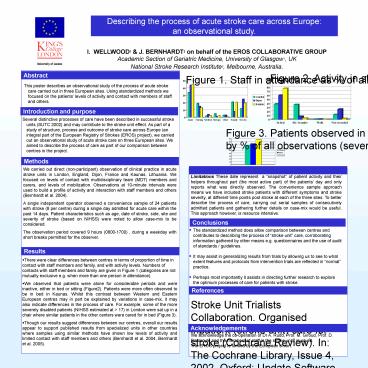Describing the process of acute stroke care across Europe: - PowerPoint PPT Presentation
1 / 1
Title:
Describing the process of acute stroke care across Europe:
Description:
Several distinctive processes of care have been described in successful stroke ... As part of a study of structure, process and outcome of stroke care across ... – PowerPoint PPT presentation
Number of Views:67
Avg rating:3.0/5.0
Title: Describing the process of acute stroke care across Europe:
1
Describing the process of acute stroke care
across Europe an observational study.
- WELLWOOD1 J. BERNHARDT2 on behalf of the EROS
COLLABORATIVE GROUP - Academic Section of Geriatric Medicine,
University of Glasgow1, UK - National Stroke Research Institute2, Melbourne,
Australia.
Abstract
Figure 2. Activity in stroke unit as of all
observations
Figure 1. Staff in attendance as of all
observations
This poster describes an observational study of
the process of acute stroke care carried out in
three European sites. Using standardized methods
we focused on the patients levels of activity
and contact with members of staff and others.
Introduction and purpose
Several distinctive processes of care have been
described in successful stroke units (SUTC 2002)
and may contribute to the stroke unit effect. As
part of a study of structure, process and outcome
of stroke care across Europe (an integral part of
the European Registry of Strokes (EROS) project),
we carried out an observational study of acute
stroke care on three European sites. We aimed to
describe the process of care as part of our
comparison between centres in the project.
Figure 3. Patients observed in bed by of all
observations (severe stroke)
Methods
We carried out direct (non-participant)
observation of clinical practice in acute stroke
units in London, England, Dijon, France and
Kaunas, Lithuania. We focused on levels of
contact with multidisciplinary team (MDT) members
and carers, and levels of mobilization.
Observations at 10-minute intervals were used to
build a profile of activity and interaction with
staff members and others (Bernhardt et al. 2004).
A single independent operator observed a
convenience sample of 24 patients with stroke (8
per centre) during a single day admitted for
acute care within the past 14 days. Patient
characteristics such as age, date of stroke,
side, site and severity of stroke (based on
NIHSS) were noted to allow case-mix to be
considered. The observation period covered 9
hours (0800-1700) , during a weekday with short
breaks permitted for the observer.
Limitations These date represent a snapshot of
patient activity and their helpers throughout
part (the most active part) of the patients day
and only reports what was directly observed. The
convenience sample approach means we have
included stroke patients with different symptoms
and stroke severity, at different time points
post stroke at each of the three sites. To better
describe the process of care, carrying out serial
samples of consecutively admitted patients and
gathering further details on case-mix would be
useful. This approach however, is resource
intensive.
Conclusions
- The standardized method does allow comparison
between centres and contributes to describing the
process of stroke unit care, corroborating
information gathered by other means e.g.
questionnaires and the use of audit of standards
/ guidelines. - It may assist in generalizing results from trials
by allowing us to see to what extent features and
protocols from intervention trials are reflected
in normal practice. - Perhaps most importantly it assists in directing
further research to explore the optimum processes
of care for patients with stroke.
Results
- There were clear differences between centres in
terms of proportion of time in contact with staff
members and family, and with activity levels.
Numbers of contacts with staff members and family
are given in Figure 1 (categories are not
mutually exclusive e.g. when more than one person
in attendance). - We observed that patients were alone for
considerable periods and were inactive, either in
bed or sitting (Figure2). Patients were more
often observed to be in bed in Kaunas. Whilst
this contrast between Western and Eastern
European centres may in part be explained by
variations in case-mix, it may also indicate
differences in the process of care. For example,
some of the more severely disabled patients
(NIHSS estimated at gt 17) in London were sat up
in a chair where similar patients in the other
centers were cared for in bed (Figure 3). - Though our results suggest differences between
our centres, overall our results appear to
support published results from specialized units
in other countries where samples using similar
methods have shown low levels of activity and
limited contact with staff members and others
(Bernhardt et al. 2004, Bernhardt et al. 2005). - .
References
Stroke Unit Trialists Collaboration. Organised
inpatient (stroke unit) care for stroke (Cochrane
Review). In The Cochrane Library, Issue 4, 2002.
Oxford Update Software. Bernhardt J, Dewey H,
Thrift A, Donnan G. Inactive and alone. Physical
activity within the first 14 days of acute stroke
unit care. Stroke. 2004351005-1009. Bernhardt
J, et al. ESC Bologna 2005 Abstract No. 781 A
comparison of physical activity patterns of
stroke patients managed in Trondheim, Norway and
Melbourne, Australia.
Acknowledgements
We acknowledge the co-operation of Dr A. Rudd,
Prof. M. Giroud, Prof. D. Rastenyte and the
members of staff in the stroke units
involved. The EROS project is funded by the
European Union.































